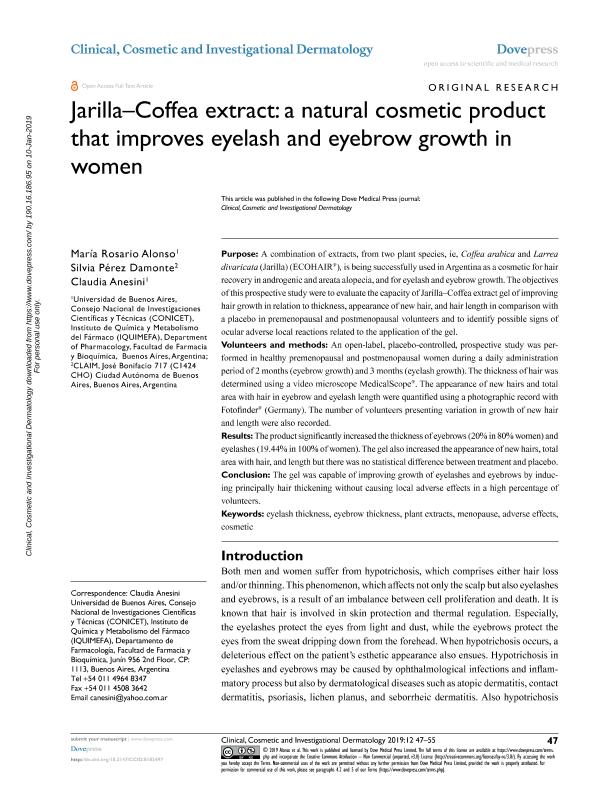Mostrar el registro sencillo del ítem
dc.contributor.author
Alonso, Maria del Rosario

dc.contributor.author
Damonte, Silvia Pérez
dc.contributor.author
Anesini, Claudia Alejandra

dc.date.available
2020-12-14T14:46:59Z
dc.date.issued
2019-01
dc.identifier.citation
Alonso, Maria del Rosario; Damonte, Silvia Pérez; Anesini, Claudia Alejandra; Jarilla–Coffea extract: A natural cosmetic product that improves eyelash and eyebrow growth in women; Dove Press; Clinical, Cosmetic and Investigational Dermatology; 12; 1-2019; 47-55
dc.identifier.issn
1178-7015
dc.identifier.uri
http://hdl.handle.net/11336/120356
dc.description.abstract
Purpose: A combination of extracts, from two plant species, ie, Coffea arabica and Larrea divaricata (Jarilla) (ECOHAIR®), is being successfully used in Argentina as a cosmetic for hair recovery in androgenic and areata alopecia, and for eyelash and eyebrow growth. The objectives of this prospective study were to evaluate the capacity of Jarilla–Coffea extract gel of improving hair growth in relation to thickness, appearance of new hair, and hair length in comparison with a placebo in premenopausal and postmenopausal volunteers and to identify possible signs of ocular adverse local reactions related to the application of the gel. Volunteers and methods: An open-label, placebo-controlled, prospective study was performed in healthy premenopausal and postmenopausal women during a daily administration period of 2 months (eyebrow growth) and 3 months (eyelash growth). The thickness of hair was determined using a video microscope MedicalScope®. The appearance of new hairs and total area with hair in eyebrow and eyelash length were quantified using a photographic record with Fotofinder® (Germany). The number of volunteers presenting variation in growth of new hair and length were also recorded. Results: The product significantly increased the thickness of eyebrows (20% in 80% women) and eyelashes (19.44% in 100% of women). The gel also increased the appearance of new hairs, total area with hair, and length but there was no statistical difference between treatment and placebo. Conclusion: The gel was capable of improving growth of eyelashes and eyebrows by inducing principally hair thickening without causing local adverse effects in a high percentage of volunteers.
dc.format
application/pdf
dc.language.iso
eng
dc.publisher
Dove Press

dc.rights
info:eu-repo/semantics/openAccess
dc.rights.uri
https://creativecommons.org/licenses/by-nc/2.5/ar/
dc.subject
ADVERSE EFFECTS
dc.subject
COSMETIC
dc.subject
EYEBROW THICKNESS
dc.subject
EYELASH THICKNESS
dc.subject
MENOPAUSE
dc.subject
PLANT EXTRACTS
dc.subject.classification
Otras Ciencias de la Salud

dc.subject.classification
Ciencias de la Salud

dc.subject.classification
CIENCIAS MÉDICAS Y DE LA SALUD

dc.title
Jarilla–Coffea extract: A natural cosmetic product that improves eyelash and eyebrow growth in women
dc.type
info:eu-repo/semantics/article
dc.type
info:ar-repo/semantics/artículo
dc.type
info:eu-repo/semantics/publishedVersion
dc.date.updated
2020-11-20T17:43:28Z
dc.journal.volume
12
dc.journal.pagination
47-55
dc.journal.pais
Nueva Zelanda

dc.journal.ciudad
Auckland
dc.description.fil
Fil: Alonso, Maria del Rosario. Consejo Nacional de Investigaciones Científicas y Técnicas. Oficina de Coordinación Administrativa Houssay. Instituto de Química y Metabolismo del Fármaco. Universidad de Buenos Aires. Facultad de Farmacia y Bioquímica. Instituto de Química y Metabolismo del Fármaco; Argentina
dc.description.fil
Fil: Damonte, Silvia Pérez. No especifíca;
dc.description.fil
Fil: Anesini, Claudia Alejandra. Consejo Nacional de Investigaciones Científicas y Técnicas. Oficina de Coordinación Administrativa Houssay. Instituto de Química y Metabolismo del Fármaco. Universidad de Buenos Aires. Facultad de Farmacia y Bioquímica. Instituto de Química y Metabolismo del Fármaco; Argentina
dc.journal.title
Clinical, Cosmetic and Investigational Dermatology
dc.relation.alternativeid
info:eu-repo/semantics/altIdentifier/doi/http://dx.doi.org/10.2147/CCID.S182497
Archivos asociados
